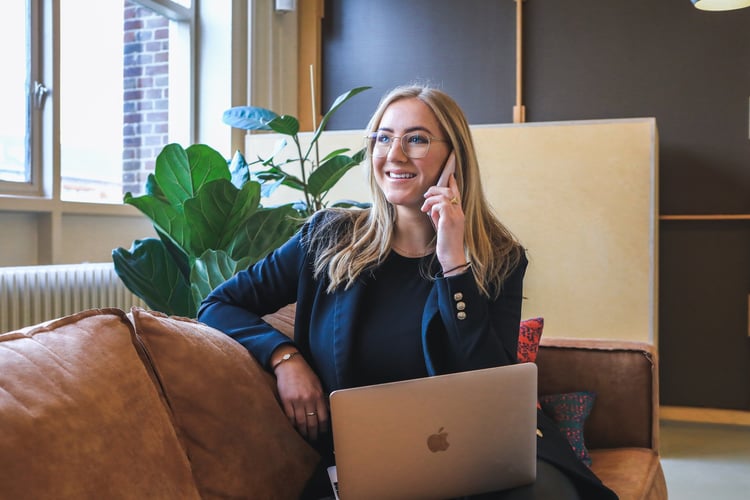Unlocking Happiness: A Strategic Guide to Crafting a Blissful Workplace

By Stavy Papasotiriou, Organisational Psychologist and Founder of Work Unlocked
"Select a job you love, and you will never have to work a day in your life."
This sentiment is a familiar one, yet in reality, even the most passionate individuals can find themselves in less-than-ideal work environments. While it's impossible to eradicate all sources of stress and dissatisfaction in the workplace, organisations bear a responsibility to cultivate an atmosphere that fosters employee well-being and happiness. This blog delves into the realm of organisational interventions—a domain where deliberate strategies can transform a lacklustre office into a thriving centre of creativity and contentment.
UNDERSTANDING THE THREE DIMENSIONS OF ORGANISATIONAL INTERVENTIONS
The world of organisational interventions is divided into three distinct levels: primary, secondary, and tertiary. Just like an architect designing a building, these interventions target different aspects of the work environment to create a harmonious whole.
- Primary Interventions (Prevention): Laying the Foundation
Think of primary interventions as the blueprint of a workplace utopia. These interventions focus on the very core of the organisation – the design, management, and overall structure of work. In other words, this is where the magic begins. It's about crafting roles that align with employees' strengths, offering a sense of purpose and autonomy. It's about fostering open lines of communication that transform supervisors from taskmasters to mentors. And let's not forget about work-life balance – an elusive creature that organisations should actively hunt down and embrace.
Example of a Primary Intervention: Designing a Blueprint for Success
A tech giant asked for my help to revamp their organisational structure, promoting collaboration, creativity, and clear communication. Having rapidly evolved from a small startup to a global leader, their culture and workflows had shifted dramatically, leaving a yearning for the days when camaraderie felt like family.
First, we conducted an in-depth analysis of their teams, identifying bottlenecks in workflow and communication. Then, in collaboration with the company's leadership, we crafted a new team structure that balanced skillsets and encouraged cross-functional interaction. Imagine the transformation: from isolated cubicles to open spaces that buzzed with collaboration. The physical shift was just the tip of the iceberg; the real magic happened in the way employees began to exchange ideas freely and create synergies that transcended their previous boundaries.
- Secondary Interventions (Correction): Equipping for Success
Certain stressors are intrinsic to job roles or industries, making complete elimination impractical. Secondary interventions tackle the individual's response to the demands of work. Imagine this as the toolkit employees can access when they face challenges. These interventions equip individuals with skills, resources, and coping mechanisms to navigate deadlines, conflicts, and high-pressure situations. Secondary interventions include workshops that enhance stress management, wellness programs that encourage physical activity, and mindfulness sessions that sharpen focus, empowering employees to tackle adversity head-on. After all, a happy workforce is a resilient one.
Example of Secondary Intervention: Empowering Emotional Intelligence
No workplace is immune to the occasional storm of stress and emotional turmoil. Especially hospitals! I was asked to introduce a secondary intervention, enhancing collaboration between nurses and doctors often caught in conflicts. After an initial thorough audit, we introduced a secondary intervention focused on enhancing emotional intelligence. Through engaging workshops and interactive sessions, we delved into the realm of emotional awareness, empathy, and effective communication. Picture a scenario where an employee, previously prone to bottling up emotions, now possesses the skills to address concerns constructively. As they say, "A well-tuned emotional radar makes for smoother seas.”
- Tertiary Interventions (Remediation): Repairing the Rifts
Even with the best-laid plans, cracks might still appear in the armour. Tertiary interventions deal with problems that have already become significant and focus on resolving existing issues, mitigating their negative effects, and helping the organisation/employees recover. This can include actions such as restructuring, crisis management, counselling for employees, and implementing strategies to regain stability and functionality.
Example of Tertiary Intervention: Sustaining the Spark
For a law firm facing challenges of decreased employee performance and morale, especially among new graduate-level lawyers, we introduced a mentorship program. The firm's increased workload, coupled with a lack of experience, long working hours, and high-pressure cases, had led to burnout and dissatisfaction. This resulted in a surge of mistakes and client complaints. To address these issues, we paired seasoned lawyers with newcomers, creating a support system that goes beyond the tasks at hand. This initiative provides ongoing guidance, eases transitions, and integrates interventions into their daily routines, ultimately strengthening employee relationships.
CONCLUSION: THE RIPPLE EFFECT OF A HAPPY WORKPLACE
Happiness is infectious. A genuinely content workforce doesn't just clock in and out; they invest themselves in the organisation's success. They become ambassadors of positivity, spreading their enthusiasm to clients, customers, and partners alike. Hence, when you step into your workplace next, pause to ponder what's needed to cultivate a psychologically healthier environment. Does your organisation necessitate primary interventions to nurture collaboration and innovation? Or secondary interventions to empower employees to thrive amid inevitable challenges? And, rest assured, are tertiary interventions in place to address any cracks in employees' well-being?
Remember, it's not just about providing your employees with a job they love; it's about cultivating a workplace that loves them back.
ABOUT THE AUTHOR
Stavy Papasotiriou is an organisational psychologist and the visionary behind Work Unlocked — a leading HR consultancy on a mission to revolutionise employee engagement, performance, and retention in businesses worldwide. With a profound understanding of HR practices, Stavy leverages psychological principles to unleash the untapped potential of workforces. At Work Unlocked, Stavy crafts bespoke strategies that are grounded in research and tailored to each organization's unique needs. These strategies are designed to yield remarkable results while requiring minimal resources.




